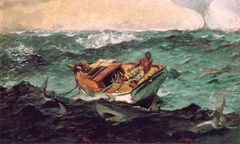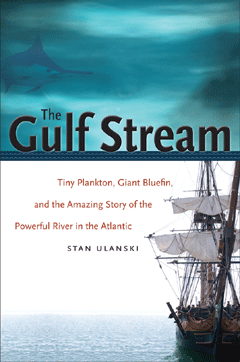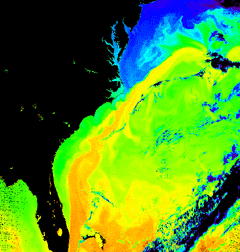The Sea Superhighway
Air Date: Week of December 5, 2008

Winslow Homer’s painting “The Gulf Stream,” 1899. (Courtesy of the Metropolitan Museum of Art)
The Gulf Stream is an important ocean current that surges northward along the eastern coast of North America. It has had a tremendous influence on climate, marine life and early exploration of the New World. In his new book, "The Gulf Stream: Tiny Plankton, Giant Bluefin, and the Amazing Story of the Powerful River in the Atlantic," Stan Ulanski, a geology professor at James Madison University, shares the story of the mighty Gulf Stream, past and present.
Transcript
GELLERMAN: A river runs through it – the Atlantic Ocean, that is. While we call it the Gulf Stream, the mighty flow of water off our east coast really behaves like a river in the ocean, writes Stan Ulanski.
Ulanski teaches geology and environmental science at James Madison University and his new book is called “The Gulf Stream: Tiny Plankton, Giant Bluefin and the Amazing Story of the Powerful River in the Atlantic.” Stan Ulanski, thanks for joining us.
ULANSKI: My pleasure to be here. Thank you.
GELLERMAN: You know, we all think we know that the Gulf Stream is but, when I was reading your book I realized I didn’t know what the Gulf Stream was.
ULANSKI: A lot of people have heard about it, but when they really try to define it, they kind of fall short. And really what the Gulf Stream is – it's actually part of a larger circulation in the Atlantic Ocean called a gyre, and the Gulf Stream is one component of it found along the western part of the of the gyre. And essentially what it is is a strong powerful, warm ocean current that starts in the southern part of Florida and flows along the Eastern Seaboard.
GELLERMAN: You write that the Gulf Stream is a wonderful place for sea life.

(Photo: Linda G. Bell)
ULANSKI: Absolutely. It’s a conduit, the sea highway, for many, many organisms that basically are tropical organisms. Most of these have no means of moving, like the tiny plankton, they literally go along with the flow. Then you have massive, giant bluefin tuna that can reach up to 1000 pounds. They spawn in the Gulf of Mexico and ride the Gulf Stream northward feeding in the fertile, rich waters off the New England coast. And sometimes they’ll travel even all the way to Europe, still riding that same current.
GELLERMAN: It’s not so much a stream, it’s really a river.
ULANSKI: It kind of is like a river. Even though it doesn’t have hard and fast banks, it does flow quite swiftly compared to its surroundings.
GELLERMAN: Boy, I’ll say. You write in the book, you say, it transports more than two billion cubic feet of water every second.
ULANSKI: That’s absolutely right. When you, in fact, when you compare the transport of the Gulf Stream compared to the Amazon and any of the other larger rivers throughout the world, it really dwarfs them.
GELLERMAN: And it’s warm. I was surprised that it’s like 80 degrees.
ULANSKI: Yeah, that’s really one of the major characteristics of Gulf Stream. If you were taking the temperatures, you’ll see the water temperatures around it are around 60, 65 degrees. And then you come to the Gulf Stream and maybe just in a short distance of a few hundred yards the temperature will jump up to about 80, 82 degrees Fahrenheit.
GELLERMAN: And it goes deep, I guess.
ULANSKI: The Gulf Stream is – yeah – they think of it as surface current, but actually it extends about 2000 to 2500 feet below the surface, so that if you were down there, it would still pull you along at those great depths.

ULANSKI: Well, it’s really a combination of factors. You’ve gotta sort of think of it as a recipe. We’ll take a little bit of the wind, take a little bit of the earth’s rotation, and what you create – you create a hill of water in the center of the ocean as the result of these two factors.
GELLERMAN: When you sail across the Gulf Stream, can you see the difference?
ULANSKI: Very easily. You can see it particularly with regard to its water color. There’s a sharp boundary between the bluish green water that is near the coast and the cobalt blue water of the Gulf Stream. And the other thing that you can see is water clarity. The coastal waters are kind of murky in appearance while the Gulf Stream is really almost really gin clear.
GELLERMAN: You actually flew over the Gulf Stream in a small plane.
ULANSKI: I did fly over the Gulf Stream, just to get sort of a more personal view of it. I’ve been on the Gulf Stream, sailed on the Gulf Stream, worked on the Gulf Stream, dove under the Gulf Stream and I said, Hey – might be kinda of interesting to take it from a different perspective, a bird’s eye view.
GELLERMAN: You really got a passion for this stream.
ULANSKI: Well, yes. Over the years I’ve developed a real passion, and to be honest with you, a real concern and love of the Gulf Stream. It’s probably one of the last vestiges of wilderness on the earth.

Winslow Homer’s painting “The Gulf Stream,” 1899. (Courtesy of the Metropolitan Museum of Art)
GELLERMAN: Well, you share your interest in the Gulf Stream with Benjamin Franklin.
ULANSKI: Oh absolutely. In fact, he took three cruises across the Gulf Stream taking in depth measurements not only at the surface, but also at the depth. And he produced one of the first maps of the Gulf Stream that was used extensively by both American and English merchants.
GELLERMAN: So if I was off the coast of Florida, put a message in a bottle and dumped it into the Gulf Stream, where did you think it would wind up?
ULANSKI: That’s a real good question, in fact, that’s how scientists really first started to study currents. They put the old proverbial message in a bottle and tried to track them. Now what they use are called little drift packets, just plastic envelopes where they put a little note in and put it in water and hopefully if somebody picks it on up, they send it back with the information of where they got it, when they got it, and so on. So we still use this proverbial message in a bottle to track currents.
GELLERMAN: Did you ever drop a message in a bottle?
ULANSKI: [Laughs] No, I never did. I did put current meters in, ah, but the meters we put in were sort of stationary where we measured the Gulf Stream and other currents from the surface downward.
GELLERMAN: I like when you say in the book, if Christopher Columbus discovered the new world, Ponce de Leon discovered the way back.
ULANSKI: Yeah, that was really, really, really critical. As the Portuguese and the Spanish started to move towards the New World looking for gold particularly, it was important to get back, and how would they get back? Because one of the critical things was they would be going in cases against the winds, particularly in the trade winds. And so Ponce de Leon, though he wasn’t looking for the way back, he was fortuitous while searching for gold in Florida, found the Gulf Stream.

The warmer current of the Gulf Stream flows to the northeast off the U.S. eastern seaboard. (Image: Donna Thomas/MODIS Ocean Group, Courtesy of NASA)
ULANSKI: The pirates knew that the Spanish galleons leaving from Havana would have to take the path back between Florida and the Bahamas, so they actually set up a number of outposts and plundered ships for decades.
GELLERMAN: Global warming is now affecting the planet. How is it affecting the Gulf Stream?
ULANSKI: Boy, that’s really a big can of worms both politically and scientifically. One school of thought goes that if the Gulf Stream stopped you could lead to an ice age. Or the other thing goes global warming will lead to an ice age. But let me try to explain this as simply as I can. Ultimately, the Gulf Stream is not an entity in itself. It’s part of a larger global conveyor belt. This global conveyor belt is kind of like the earth’s thermostat. It flows throughout the globe both at the surface and at the deeper parts, and it moves water - both warm and cold water. So the idea if this conveyor belt stopped, well then, temperatures would change. If you had global warming, that could lead to melting of the ice caps and the glaciers - puts a tremendous amount of fresh water in the North Atlantic. This fresh water would decrease the density of the Gulf Stream, and so part of the Gulf Stream that sinks would no longer sink and therefore that whole conveyor belt would be disrupted and, the scenario goes, if you disrupt the conveyor belt, you prevent some of the heat being transported, hence the beginning of the ice age. In fact, some people believe that’s how the ice ages have occurred. The conveyor belt has been interrupted.
GELLERMAN: It’s interesting that something so big and so powerful has drawn so little public interest.
ULANSKI: You’re absolutely right. Again, it’s drawn a lot of scientific interest, but scientists basically write for other scientists. And I think one of my goals was to sort of get the Gulf Stream out of its sort of narrow point of view and bring it to a bigger audience.
GELLERMAN: Well, Professor Ulanski, thank you so very much,
ULANSKI: It was my pleasure, thank you.
GELLERMAN: Stan Ulanski is a professor of geology and environmental science at James Madison University. His new book is called “The Gulf Stream.”
Links
Living on Earth wants to hear from you!
Living on Earth
62 Calef Highway, Suite 212
Lee, NH 03861
Telephone: 617-287-4121
E-mail: comments@loe.org
Newsletter [Click here]
Donate to Living on Earth!
Living on Earth is an independent media program and relies entirely on contributions from listeners and institutions supporting public service. Please donate now to preserve an independent environmental voice.
NewsletterLiving on Earth offers a weekly delivery of the show's rundown to your mailbox. Sign up for our newsletter today!
 Sailors For The Sea: Be the change you want to sea.
Sailors For The Sea: Be the change you want to sea.
 The Grantham Foundation for the Protection of the Environment: Committed to protecting and improving the health of the global environment.
The Grantham Foundation for the Protection of the Environment: Committed to protecting and improving the health of the global environment.
 Contribute to Living on Earth and receive, as our gift to you, an archival print of one of Mark Seth Lender's extraordinary wildlife photographs. Follow the link to see Mark's current collection of photographs.
Contribute to Living on Earth and receive, as our gift to you, an archival print of one of Mark Seth Lender's extraordinary wildlife photographs. Follow the link to see Mark's current collection of photographs.
 Buy a signed copy of Mark Seth Lender's book Smeagull the Seagull & support Living on Earth
Buy a signed copy of Mark Seth Lender's book Smeagull the Seagull & support Living on Earth

